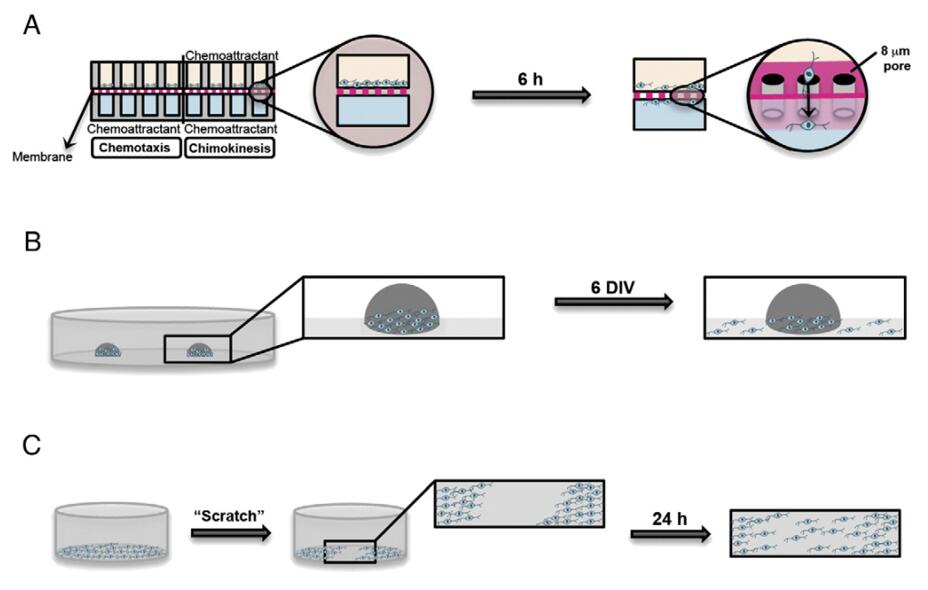The process of remyelination can be divided into two primary stages. Initially, oligodendrocyte progenitor cells (OPCs) are recruited through proliferation and potentially migration. Subsequently, these OPCs interact with demyelinated axons and transform into oligodendrocytes that form myelin sheaths. It is possible for the remyelination process to fail at either of these stages, both of which become less effective with aging, which likely contributes to the decline in remyelination efficiency observed during the disease.
Creative Bioarray offers a range of assays to evaluate OPCs (Oligodendrocyte Progenitor Cells) migration, which is crucial for processes like remyelination in the central nervous system.
 Figure 1. Different assays to evaluate OPC migration and demonstration of possible evaluations.
(A) In the Boyden chamber migration assay, oligodendrocyte precursor cells (OPC) migrate through pores, during 6–24 h, from the upper chamber, where OPC are
plated, to a lower chamber. In chemotaxis assays, only the medium in the bottom well contains the chemoattractant, whereas in chemokinetic assays the
chemoattractant is added to both lower and upper wells of the chamber, thereby eliminating a chemical gradient. (B) In the agarose drop assay, OPC migrate
away from a small drop containing a high concentration of cells. Cell migration is measured until 6 days in vitro (DIV) using a phase contrast microscope.
(C) The scratch assay consists of the creation of an artificial gap on a confluent OPC monolayer and subsequent OPC migration at the edge of the gap to
close the "scratch".
Figure 1. Different assays to evaluate OPC migration and demonstration of possible evaluations.
(A) In the Boyden chamber migration assay, oligodendrocyte precursor cells (OPC) migrate through pores, during 6–24 h, from the upper chamber, where OPC are
plated, to a lower chamber. In chemotaxis assays, only the medium in the bottom well contains the chemoattractant, whereas in chemokinetic assays the
chemoattractant is added to both lower and upper wells of the chamber, thereby eliminating a chemical gradient. (B) In the agarose drop assay, OPC migrate
away from a small drop containing a high concentration of cells. Cell migration is measured until 6 days in vitro (DIV) using a phase contrast microscope.
(C) The scratch assay consists of the creation of an artificial gap on a confluent OPC monolayer and subsequent OPC migration at the edge of the gap to
close the "scratch".
Reference:
1. Barateiro A, Fernandes A. Temporal oligodendrocyte lineage progression: in vitro models of proliferation, differentiation and myelination. Biochim Biophys Acta. 2014;1843(9):1917-1929. doi:10.1016/j.bbamcr.2014.04.018.
Online Inquiry